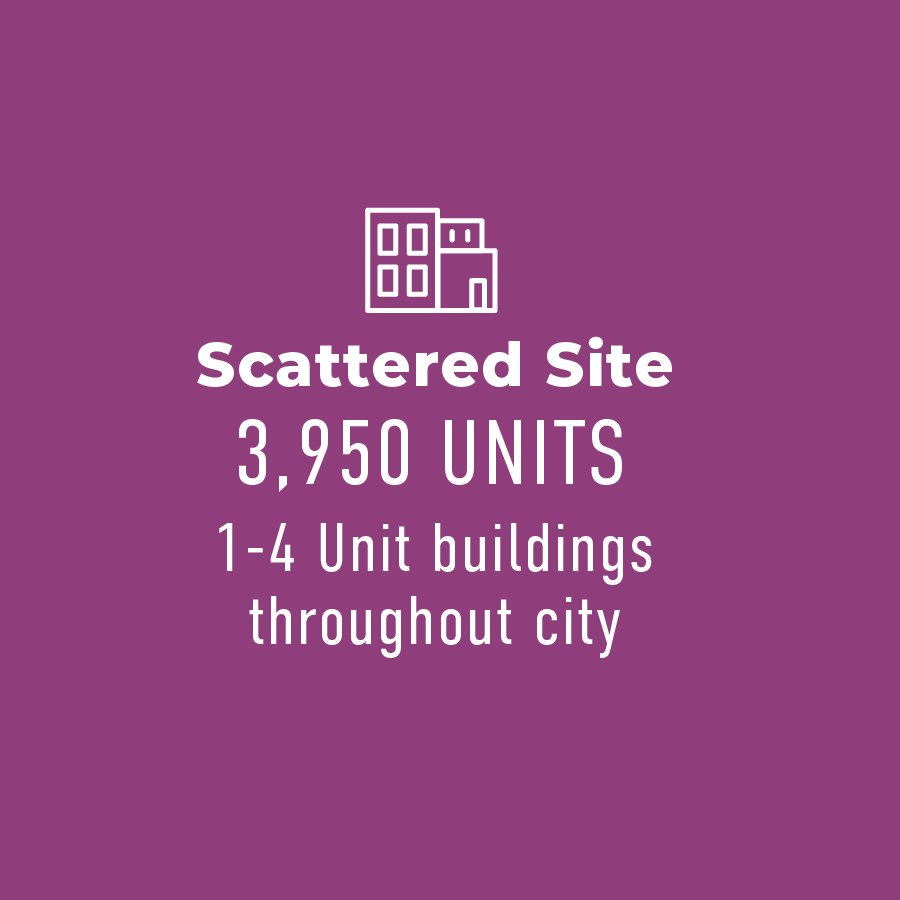PHA’s Preservation Strategy
A major part of PHA’s Opening Doors Initiative involves investing in the preservation of 12,900 existing affordable apartments, which have served Philadelphia’s renters for decades. These homes need repairs and upgrades. To plan for these improvements, PHA has organized its existing housing into three portfolios:
Scattered site: buildings of 1 to 4 units located throughout the city.
Redevelopment: large-scale multifamily developments which have significant design, structural and/or building system deficiencies in need of major repairs.
Rehabilitation: other PHA multifamily sites with minimal to moderate rehabilitation needs.
PHA expects to continue to refine these groupings as more is known about site conditions and financing needs. Below is more information about each portfolio:
Scattered site portfolio
This portfolio includes over 3,900 housing units, each with 1 to 4 units. Most are early 20th-century row houses that were acquired in the 1960s and 1970s. PHA has spent $75 million in the last decade to repair and upgrade this inventory.
Based on recent assessments, the scattered site inventory requires approximately $193.5 million in repairs. In accordance with the federal government’s regulations for demolition and disposition (Section 18 of the Housing Act), PHA plans to complete necessary repairs, transfer ownership to a PHA affiliate and convert scattered sites to the Section 8 Project Based Voucher program beginning in 2025.
Permanent affordability and resident protections will be legally binding upon disposition. PHA may refinance this inventory following conversion to generate proceeds to support other preservation activities in its portfolio.
Part of PHA’s plan is to continue to upgrade the 3,900 units in its scattered site portfolio.
PHA scattered site examples
Redevelopment portfolio
This portfolio includes over 3,800 housing units in 13 multifamily developments developed during the 1930s, 1940s and 1950s. These properties generally have one or more characteristics which call for complete redevelopment:
Inappropriate building design, site lay-out, and density
Inadequately sized living and storage spaces.
Structural and/or building system deficiencies
Poor connectivity to the surrounding neighborhoods
Inaccessibility for persons with disabilities.
Norris Apartments is an example of PHA replacing aging public housing.
PHA will draw on its experience to design strategies for these properties. Currently, PHA has six major redevelopment projects that are in the planning stages, in construction or recently completed. These include the recently completed North Central/Norris Apartments and the nearly completed Sharswood/Blumberg projects.
Both were developed as part of the federal government’s Choice Neighborhoods Program, which supports community-wide initiatives to revitalize public housing and address challenges in the surrounding neighborhood. Improvements at North/Central Norris and Sharswood Blumberg include new mixed-income housing, one-for-one replacement of the original public housing units, neighborhood amenities, extensive economic development, and supportive service initiatives. Other properties that are currently slated for redevelopment include Bartram Village (which was also awarded a $50 million Choice Neighborhoods Implementation Grant), West Park, Fairhill and Harrison Park Low-Rise.
PHA’s redevelopment programs typically involve partnerships with developers and complex financing using special grants, tax credits and other public funds. Partnerships with developers incorporate permanent affordability and resident protection provisions. Affordable housing units are subsidized using Section 8 Project Based Vouchers resulting from RAD conversions or Section 18 dispositions.
While the objective is to redevelop all sites in this category over the next 10 years, the timing of depends on many factors including availability of tax credits, other financing, interest rates and the like.
PHA redevelopment examples
Rehabilitation portfolio
This portfolio encompasses over 5,100 units at more than 60 sites. This includes both older (1960s era) and newer sites with varying rehab needs but not significant redesign or reconfiguration.
Rehabilitation sites will be converted to the Section 8 Project Based Voucher Program using either the federal government’s Rental Assistance Demonstration (RAD) or Section 18 method. This includes properties with lighter needs, where PHA may fund repairs directly, as well as properties with more substantial needs, which will likely involve mortgage financing and/or 4% Low Income Housing Tax Credits. For any 4% transactions, PHA will, where it has the capacity, serve as the developer. In other cases PHA will seek third-party development partners, but will always retain ownership of the land through “right of first refusal”.
PHA worked with a development partner to rehabilitate Courtyard at Riverview.
PHA rehabilitation examples
















